Myers-Briggs Report: Understanding Personality and Career Prospects
VerifiedAdded on 2023/04/21
|12
|2659
|276
Report
AI Summary
This report provides a comprehensive analysis of a student's Myers-Briggs Type Indicator (MBTI) results. It begins with an executive summary highlighting the benefits of understanding personality types for self-awareness, team building, and career development. The introduction explains the origins and purpose of the MBTI, emphasizing its role in assessing psychological preferences. The student reflects on their MBTI profile (ENFJ), discussing their strengths, such as empathy and leadership, and weaknesses, such as a tendency to prioritize others' needs. The report further explores the student's employability prospects, considering roles like biomedical scientist and epidemiologist, and linking the MBTI results to their skills and learning style. It includes reflections on personal experiences, such as a group project, and discusses setbacks and lessons learned. The conclusion summarizes the value of the MBTI in understanding personality and its practical applications in both personal and professional contexts. The assignment is a reflective piece on the student's MBTI results, discussing their strengths, weaknesses, career prospects, and how they can apply their findings in their life.
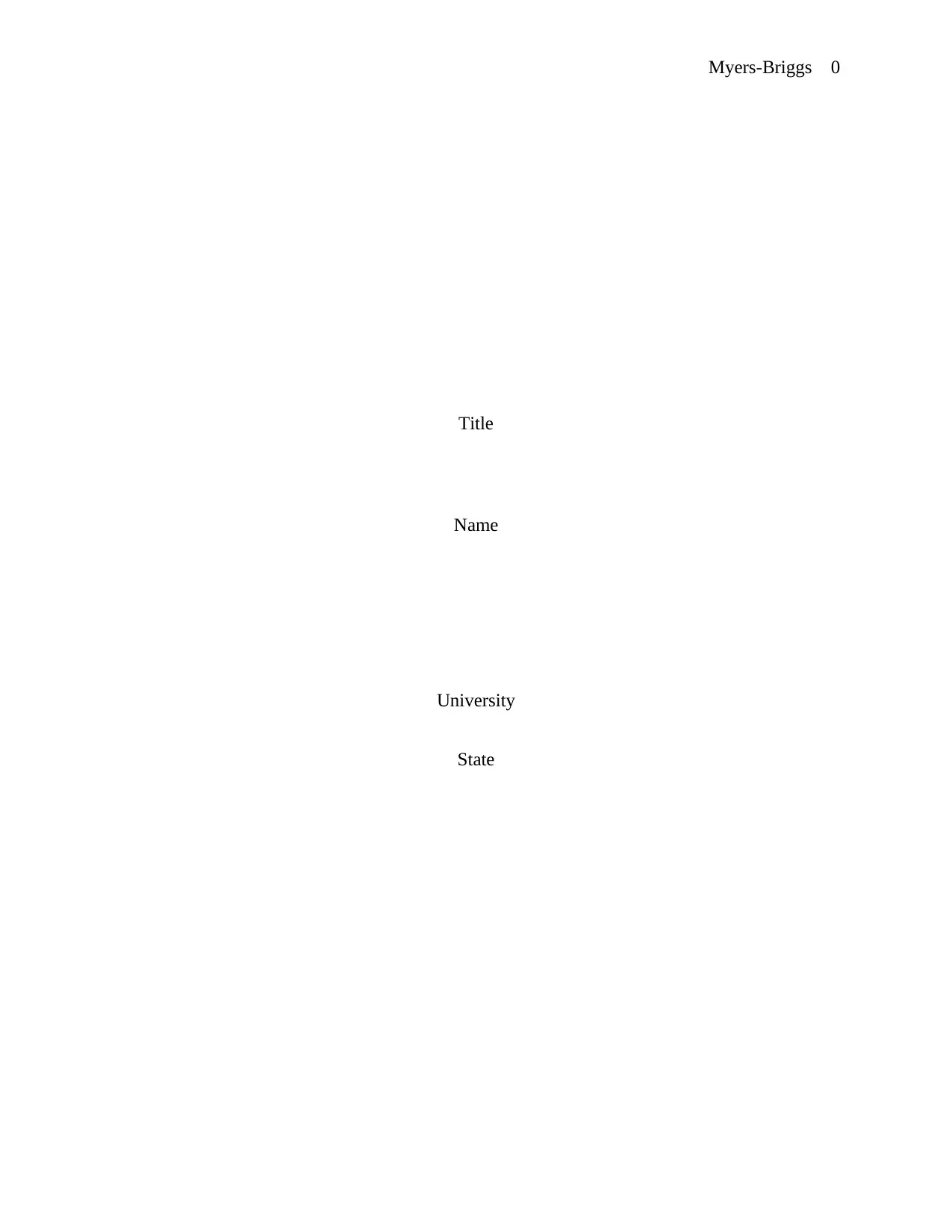
Myers-Briggs 0
Title
Name
University
State
Title
Name
University
State
Paraphrase This Document
Need a fresh take? Get an instant paraphrase of this document with our AI Paraphraser
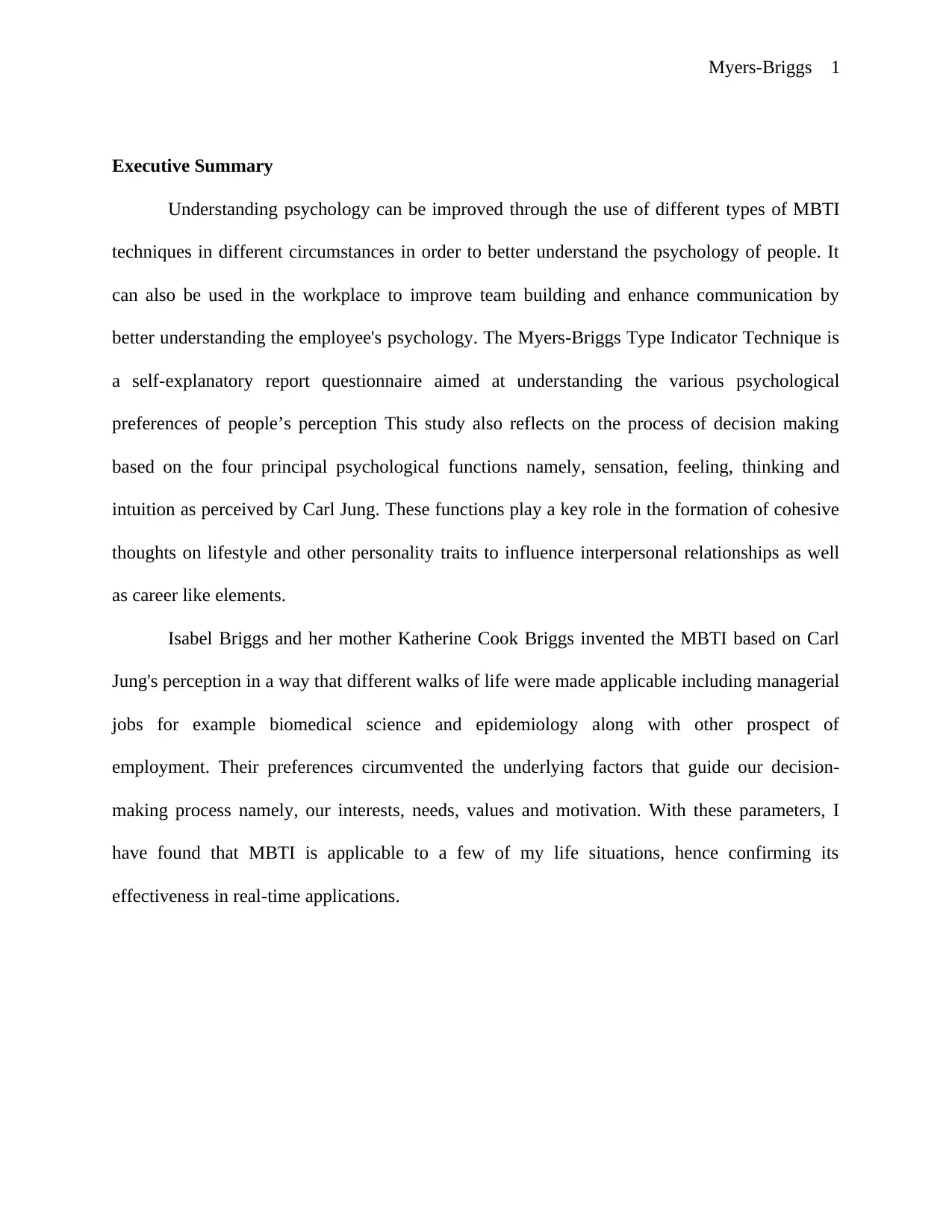
Myers-Briggs 1
Executive Summary
Understanding psychology can be improved through the use of different types of MBTI
techniques in different circumstances in order to better understand the psychology of people. It
can also be used in the workplace to improve team building and enhance communication by
better understanding the employee's psychology. The Myers-Briggs Type Indicator Technique is
a self-explanatory report questionnaire aimed at understanding the various psychological
preferences of people’s perception This study also reflects on the process of decision making
based on the four principal psychological functions namely, sensation, feeling, thinking and
intuition as perceived by Carl Jung. These functions play a key role in the formation of cohesive
thoughts on lifestyle and other personality traits to influence interpersonal relationships as well
as career like elements.
Isabel Briggs and her mother Katherine Cook Briggs invented the MBTI based on Carl
Jung's perception in a way that different walks of life were made applicable including managerial
jobs for example biomedical science and epidemiology along with other prospect of
employment. Their preferences circumvented the underlying factors that guide our decision-
making process namely, our interests, needs, values and motivation. With these parameters, I
have found that MBTI is applicable to a few of my life situations, hence confirming its
effectiveness in real-time applications.
Executive Summary
Understanding psychology can be improved through the use of different types of MBTI
techniques in different circumstances in order to better understand the psychology of people. It
can also be used in the workplace to improve team building and enhance communication by
better understanding the employee's psychology. The Myers-Briggs Type Indicator Technique is
a self-explanatory report questionnaire aimed at understanding the various psychological
preferences of people’s perception This study also reflects on the process of decision making
based on the four principal psychological functions namely, sensation, feeling, thinking and
intuition as perceived by Carl Jung. These functions play a key role in the formation of cohesive
thoughts on lifestyle and other personality traits to influence interpersonal relationships as well
as career like elements.
Isabel Briggs and her mother Katherine Cook Briggs invented the MBTI based on Carl
Jung's perception in a way that different walks of life were made applicable including managerial
jobs for example biomedical science and epidemiology along with other prospect of
employment. Their preferences circumvented the underlying factors that guide our decision-
making process namely, our interests, needs, values and motivation. With these parameters, I
have found that MBTI is applicable to a few of my life situations, hence confirming its
effectiveness in real-time applications.
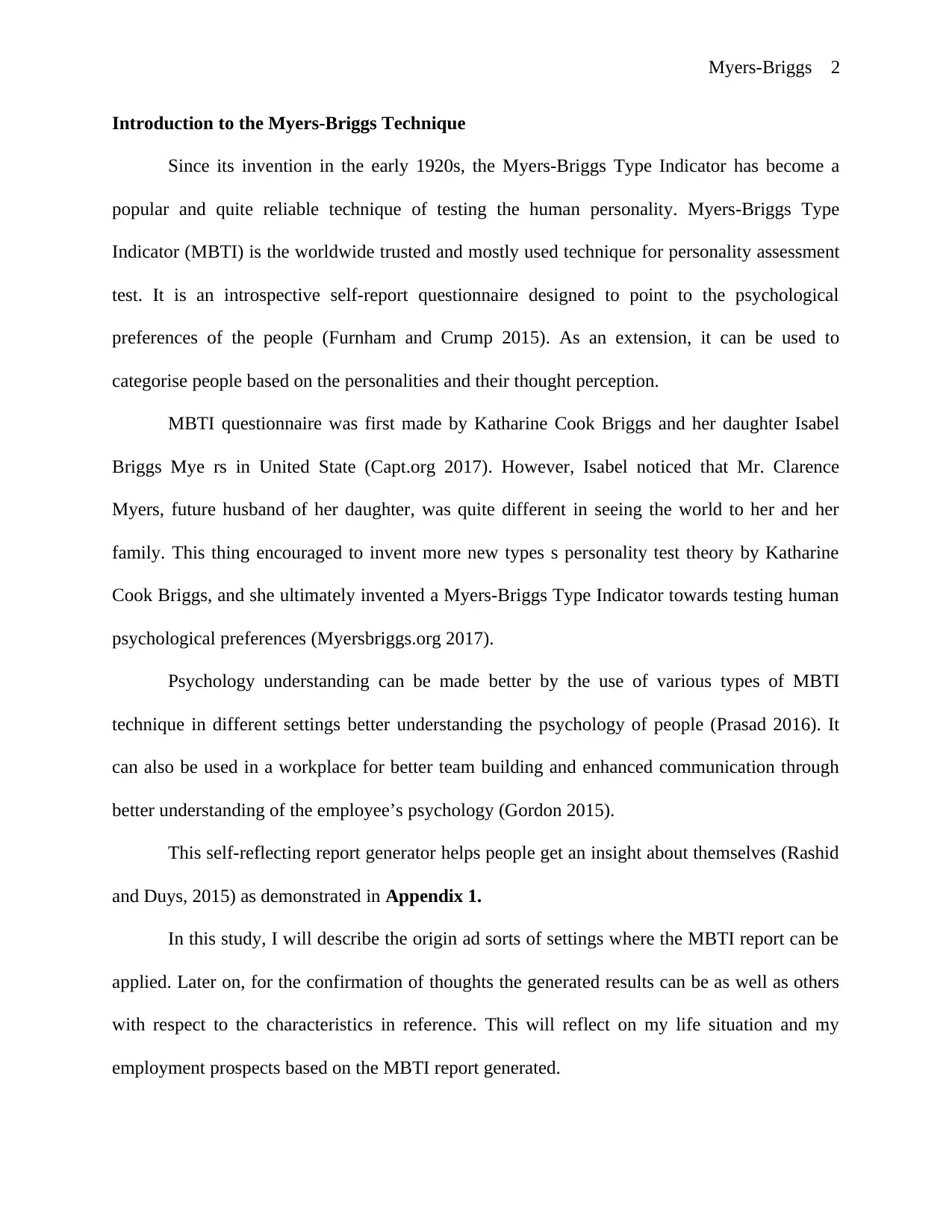
Myers-Briggs 2
Introduction to the Myers-Briggs Technique
Since its invention in the early 1920s, the Myers-Briggs Type Indicator has become a
popular and quite reliable technique of testing the human personality. Myers-Briggs Type
Indicator (MBTI) is the worldwide trusted and mostly used technique for personality assessment
test. It is an introspective self-report questionnaire designed to point to the psychological
preferences of the people (Furnham and Crump 2015). As an extension, it can be used to
categorise people based on the personalities and their thought perception.
MBTI questionnaire was first made by Katharine Cook Briggs and her daughter Isabel
Briggs Mye rs in United State (Capt.org 2017). However, Isabel noticed that Mr. Clarence
Myers, future husband of her daughter, was quite different in seeing the world to her and her
family. This thing encouraged to invent more new types s personality test theory by Katharine
Cook Briggs, and she ultimately invented a Myers-Briggs Type Indicator towards testing human
psychological preferences (Myersbriggs.org 2017).
Psychology understanding can be made better by the use of various types of MBTI
technique in different settings better understanding the psychology of people (Prasad 2016). It
can also be used in a workplace for better team building and enhanced communication through
better understanding of the employee’s psychology (Gordon 2015).
This self-reflecting report generator helps people get an insight about themselves (Rashid
and Duys, 2015) as demonstrated in Appendix 1.
In this study, I will describe the origin ad sorts of settings where the MBTI report can be
applied. Later on, for the confirmation of thoughts the generated results can be as well as others
with respect to the characteristics in reference. This will reflect on my life situation and my
employment prospects based on the MBTI report generated.
Introduction to the Myers-Briggs Technique
Since its invention in the early 1920s, the Myers-Briggs Type Indicator has become a
popular and quite reliable technique of testing the human personality. Myers-Briggs Type
Indicator (MBTI) is the worldwide trusted and mostly used technique for personality assessment
test. It is an introspective self-report questionnaire designed to point to the psychological
preferences of the people (Furnham and Crump 2015). As an extension, it can be used to
categorise people based on the personalities and their thought perception.
MBTI questionnaire was first made by Katharine Cook Briggs and her daughter Isabel
Briggs Mye rs in United State (Capt.org 2017). However, Isabel noticed that Mr. Clarence
Myers, future husband of her daughter, was quite different in seeing the world to her and her
family. This thing encouraged to invent more new types s personality test theory by Katharine
Cook Briggs, and she ultimately invented a Myers-Briggs Type Indicator towards testing human
psychological preferences (Myersbriggs.org 2017).
Psychology understanding can be made better by the use of various types of MBTI
technique in different settings better understanding the psychology of people (Prasad 2016). It
can also be used in a workplace for better team building and enhanced communication through
better understanding of the employee’s psychology (Gordon 2015).
This self-reflecting report generator helps people get an insight about themselves (Rashid
and Duys, 2015) as demonstrated in Appendix 1.
In this study, I will describe the origin ad sorts of settings where the MBTI report can be
applied. Later on, for the confirmation of thoughts the generated results can be as well as others
with respect to the characteristics in reference. This will reflect on my life situation and my
employment prospects based on the MBTI report generated.
⊘ This is a preview!⊘
Do you want full access?
Subscribe today to unlock all pages.

Trusted by 1+ million students worldwide
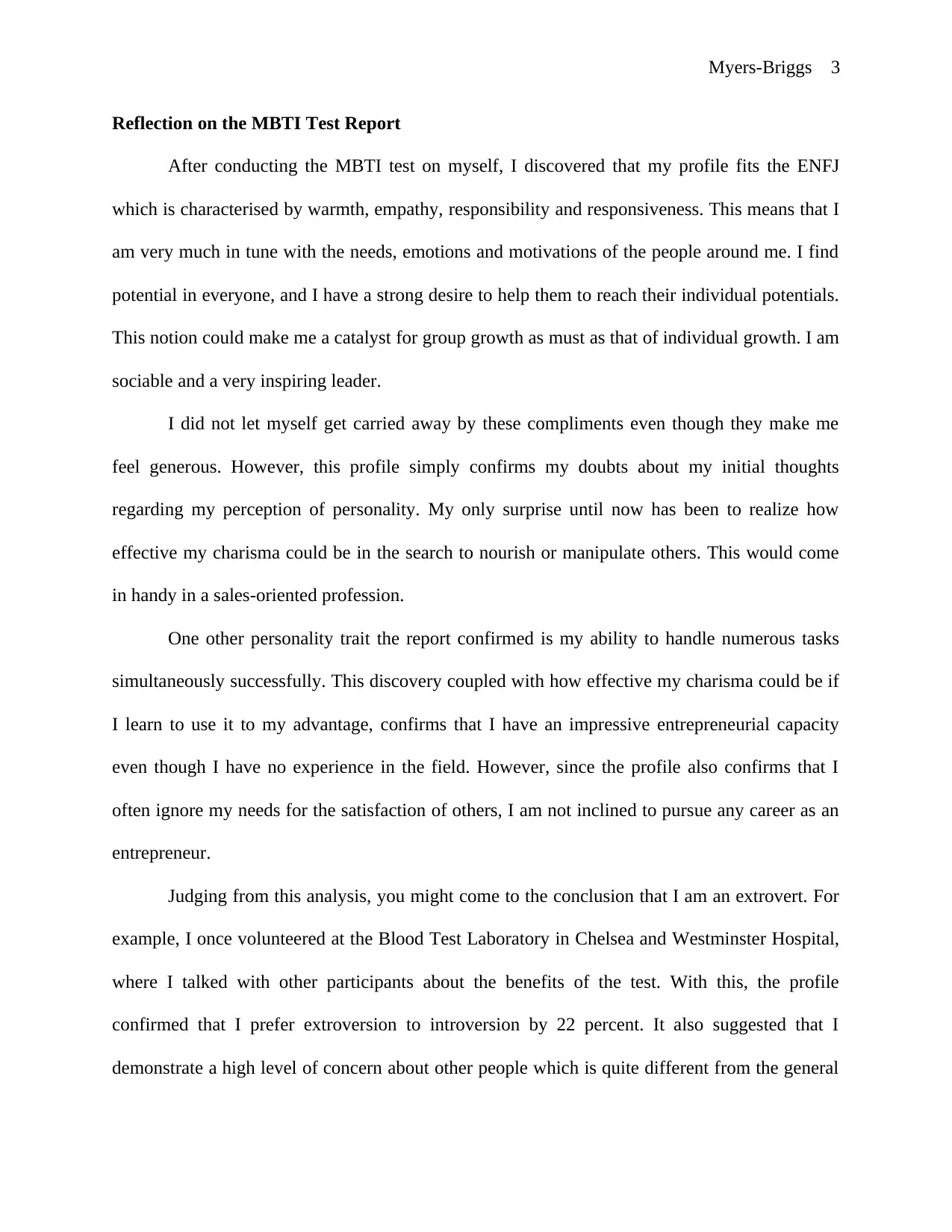
Myers-Briggs 3
Reflection on the MBTI Test Report
After conducting the MBTI test on myself, I discovered that my profile fits the ENFJ
which is characterised by warmth, empathy, responsibility and responsiveness. This means that I
am very much in tune with the needs, emotions and motivations of the people around me. I find
potential in everyone, and I have a strong desire to help them to reach their individual potentials.
This notion could make me a catalyst for group growth as must as that of individual growth. I am
sociable and a very inspiring leader.
I did not let myself get carried away by these compliments even though they make me
feel generous. However, this profile simply confirms my doubts about my initial thoughts
regarding my perception of personality. My only surprise until now has been to realize how
effective my charisma could be in the search to nourish or manipulate others. This would come
in handy in a sales-oriented profession.
One other personality trait the report confirmed is my ability to handle numerous tasks
simultaneously successfully. This discovery coupled with how effective my charisma could be if
I learn to use it to my advantage, confirms that I have an impressive entrepreneurial capacity
even though I have no experience in the field. However, since the profile also confirms that I
often ignore my needs for the satisfaction of others, I am not inclined to pursue any career as an
entrepreneur.
Judging from this analysis, you might come to the conclusion that I am an extrovert. For
example, I once volunteered at the Blood Test Laboratory in Chelsea and Westminster Hospital,
where I talked with other participants about the benefits of the test. With this, the profile
confirmed that I prefer extroversion to introversion by 22 percent. It also suggested that I
demonstrate a high level of concern about other people which is quite different from the general
Reflection on the MBTI Test Report
After conducting the MBTI test on myself, I discovered that my profile fits the ENFJ
which is characterised by warmth, empathy, responsibility and responsiveness. This means that I
am very much in tune with the needs, emotions and motivations of the people around me. I find
potential in everyone, and I have a strong desire to help them to reach their individual potentials.
This notion could make me a catalyst for group growth as must as that of individual growth. I am
sociable and a very inspiring leader.
I did not let myself get carried away by these compliments even though they make me
feel generous. However, this profile simply confirms my doubts about my initial thoughts
regarding my perception of personality. My only surprise until now has been to realize how
effective my charisma could be in the search to nourish or manipulate others. This would come
in handy in a sales-oriented profession.
One other personality trait the report confirmed is my ability to handle numerous tasks
simultaneously successfully. This discovery coupled with how effective my charisma could be if
I learn to use it to my advantage, confirms that I have an impressive entrepreneurial capacity
even though I have no experience in the field. However, since the profile also confirms that I
often ignore my needs for the satisfaction of others, I am not inclined to pursue any career as an
entrepreneur.
Judging from this analysis, you might come to the conclusion that I am an extrovert. For
example, I once volunteered at the Blood Test Laboratory in Chelsea and Westminster Hospital,
where I talked with other participants about the benefits of the test. With this, the profile
confirmed that I prefer extroversion to introversion by 22 percent. It also suggested that I
demonstrate a high level of concern about other people which is quite different from the general
Paraphrase This Document
Need a fresh take? Get an instant paraphrase of this document with our AI Paraphraser
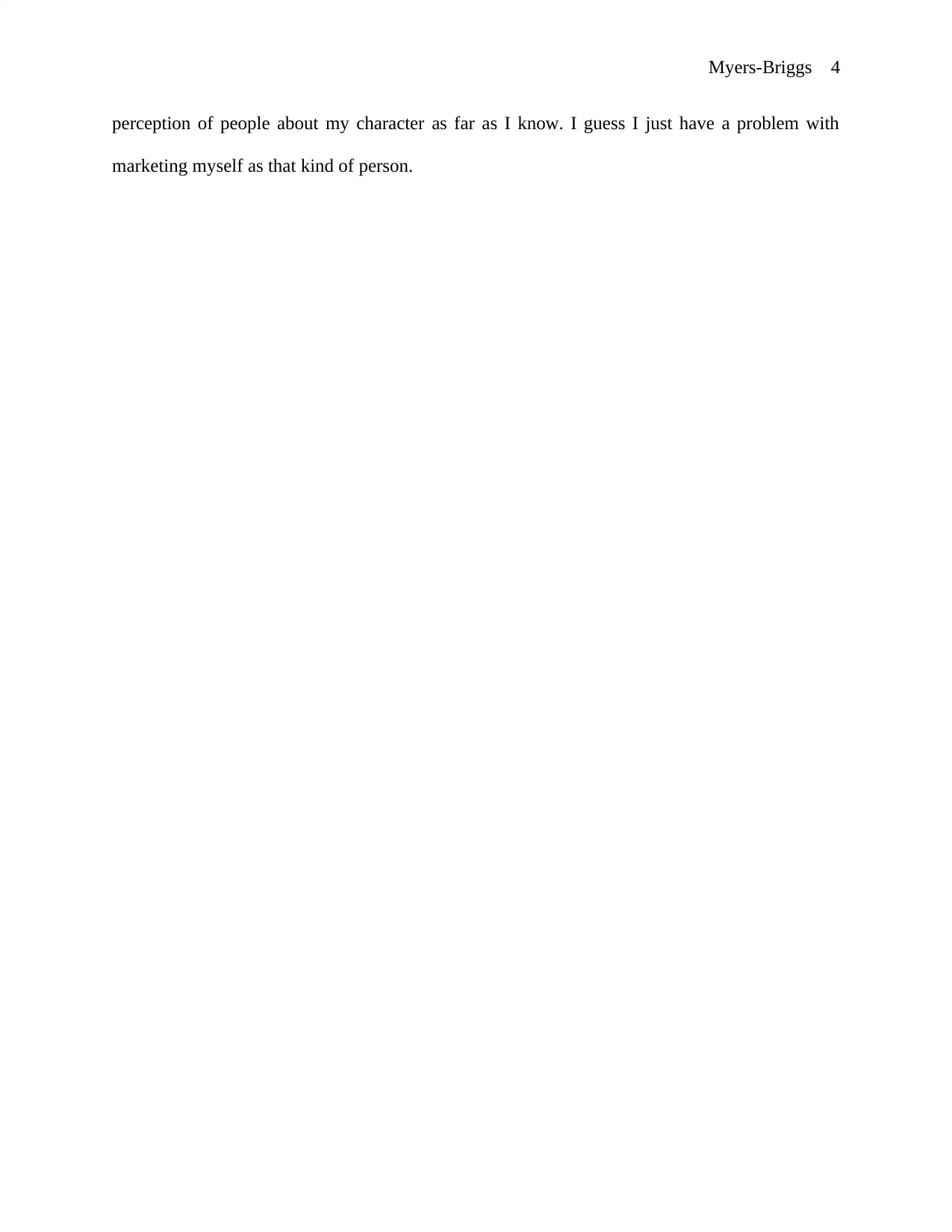
Myers-Briggs 4
perception of people about my character as far as I know. I guess I just have a problem with
marketing myself as that kind of person.
perception of people about my character as far as I know. I guess I just have a problem with
marketing myself as that kind of person.
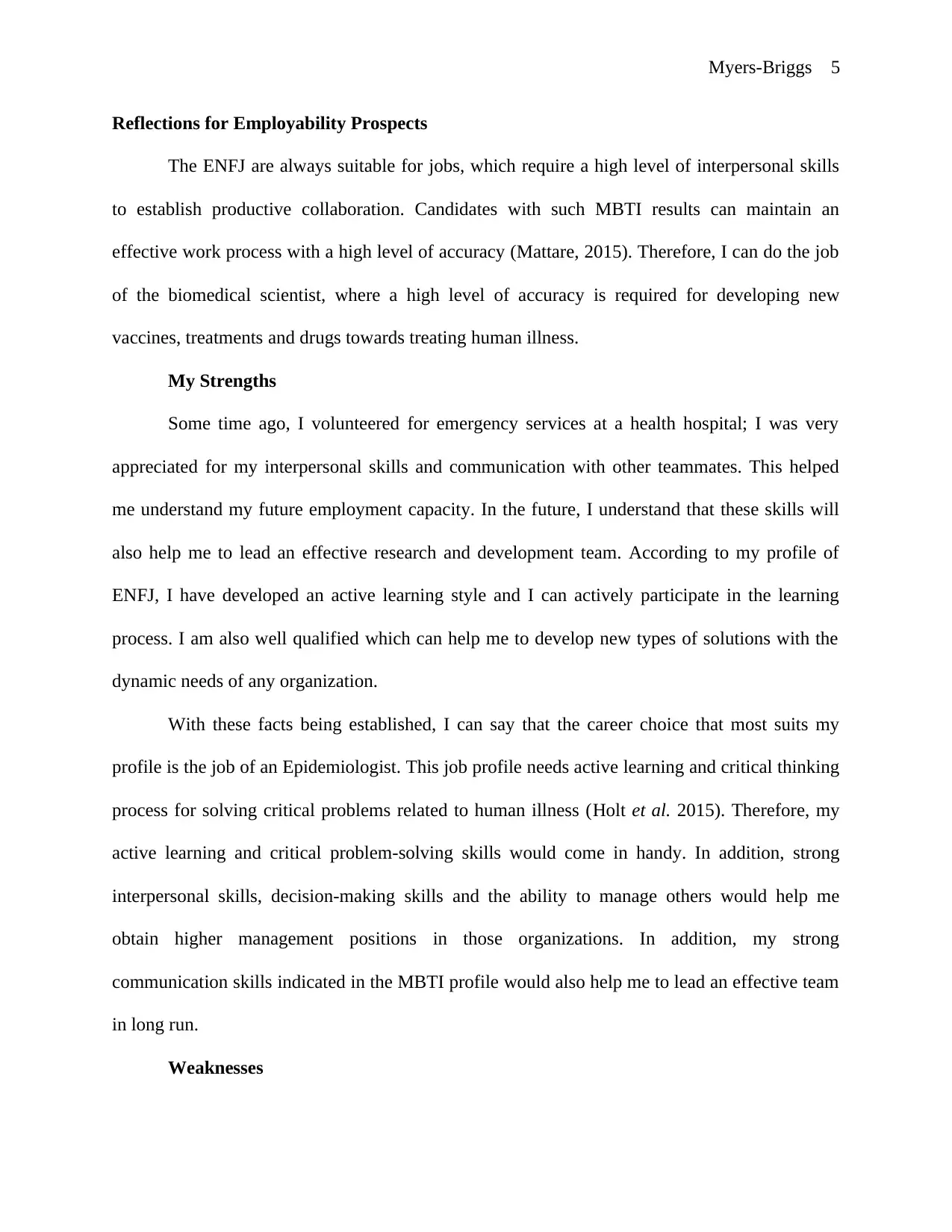
Myers-Briggs 5
Reflections for Employability Prospects
The ENFJ are always suitable for jobs, which require a high level of interpersonal skills
to establish productive collaboration. Candidates with such MBTI results can maintain an
effective work process with a high level of accuracy (Mattare, 2015). Therefore, I can do the job
of the biomedical scientist, where a high level of accuracy is required for developing new
vaccines, treatments and drugs towards treating human illness.
My Strengths
Some time ago, I volunteered for emergency services at a health hospital; I was very
appreciated for my interpersonal skills and communication with other teammates. This helped
me understand my future employment capacity. In the future, I understand that these skills will
also help me to lead an effective research and development team. According to my profile of
ENFJ, I have developed an active learning style and I can actively participate in the learning
process. I am also well qualified which can help me to develop new types of solutions with the
dynamic needs of any organization.
With these facts being established, I can say that the career choice that most suits my
profile is the job of an Epidemiologist. This job profile needs active learning and critical thinking
process for solving critical problems related to human illness (Holt et al. 2015). Therefore, my
active learning and critical problem-solving skills would come in handy. In addition, strong
interpersonal skills, decision-making skills and the ability to manage others would help me
obtain higher management positions in those organizations. In addition, my strong
communication skills indicated in the MBTI profile would also help me to lead an effective team
in long run.
Weaknesses
Reflections for Employability Prospects
The ENFJ are always suitable for jobs, which require a high level of interpersonal skills
to establish productive collaboration. Candidates with such MBTI results can maintain an
effective work process with a high level of accuracy (Mattare, 2015). Therefore, I can do the job
of the biomedical scientist, where a high level of accuracy is required for developing new
vaccines, treatments and drugs towards treating human illness.
My Strengths
Some time ago, I volunteered for emergency services at a health hospital; I was very
appreciated for my interpersonal skills and communication with other teammates. This helped
me understand my future employment capacity. In the future, I understand that these skills will
also help me to lead an effective research and development team. According to my profile of
ENFJ, I have developed an active learning style and I can actively participate in the learning
process. I am also well qualified which can help me to develop new types of solutions with the
dynamic needs of any organization.
With these facts being established, I can say that the career choice that most suits my
profile is the job of an Epidemiologist. This job profile needs active learning and critical thinking
process for solving critical problems related to human illness (Holt et al. 2015). Therefore, my
active learning and critical problem-solving skills would come in handy. In addition, strong
interpersonal skills, decision-making skills and the ability to manage others would help me
obtain higher management positions in those organizations. In addition, my strong
communication skills indicated in the MBTI profile would also help me to lead an effective team
in long run.
Weaknesses
⊘ This is a preview!⊘
Do you want full access?
Subscribe today to unlock all pages.

Trusted by 1+ million students worldwide
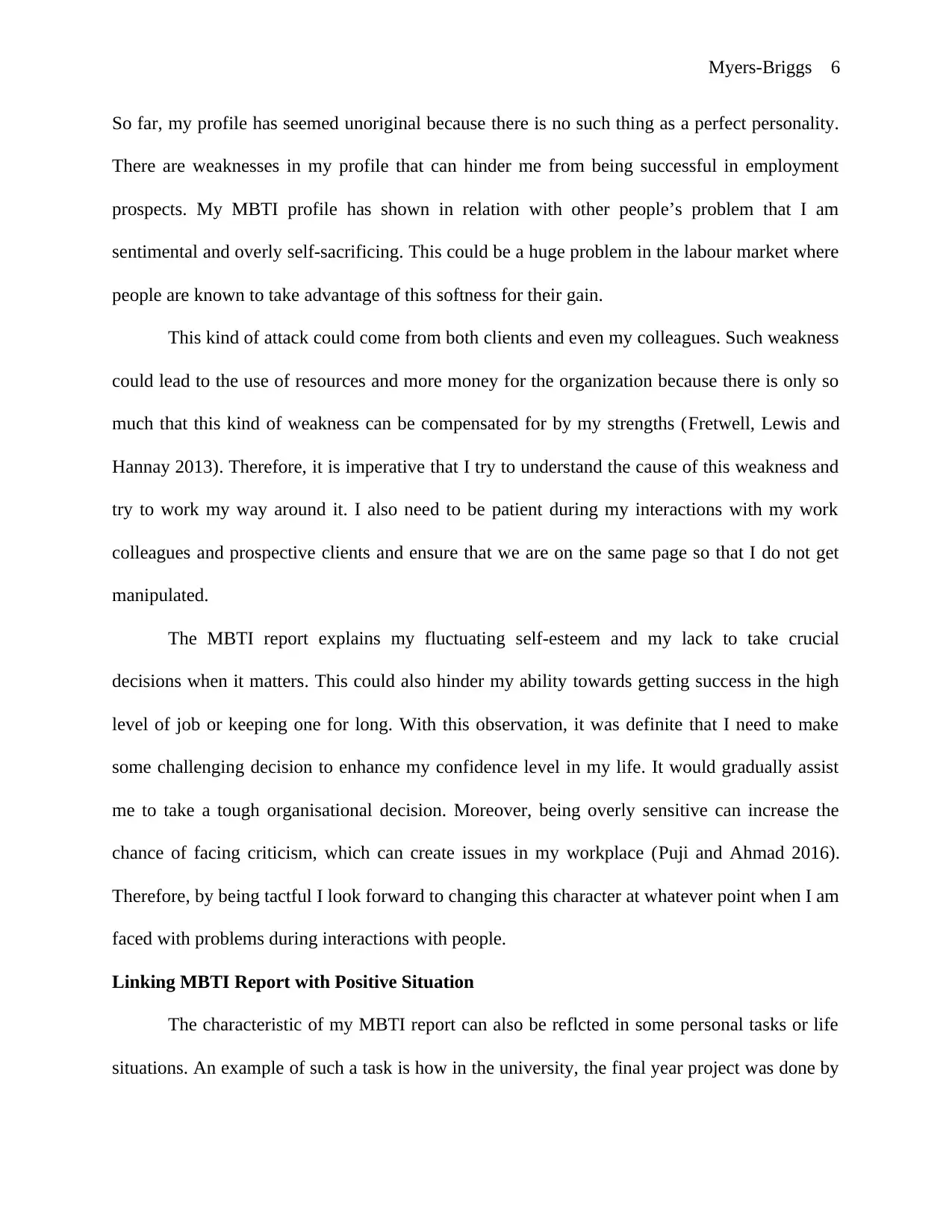
Myers-Briggs 6
So far, my profile has seemed unoriginal because there is no such thing as a perfect personality.
There are weaknesses in my profile that can hinder me from being successful in employment
prospects. My MBTI profile has shown in relation with other people’s problem that I am
sentimental and overly self-sacrificing. This could be a huge problem in the labour market where
people are known to take advantage of this softness for their gain.
This kind of attack could come from both clients and even my colleagues. Such weakness
could lead to the use of resources and more money for the organization because there is only so
much that this kind of weakness can be compensated for by my strengths (Fretwell, Lewis and
Hannay 2013). Therefore, it is imperative that I try to understand the cause of this weakness and
try to work my way around it. I also need to be patient during my interactions with my work
colleagues and prospective clients and ensure that we are on the same page so that I do not get
manipulated.
The MBTI report explains my fluctuating self-esteem and my lack to take crucial
decisions when it matters. This could also hinder my ability towards getting success in the high
level of job or keeping one for long. With this observation, it was definite that I need to make
some challenging decision to enhance my confidence level in my life. It would gradually assist
me to take a tough organisational decision. Moreover, being overly sensitive can increase the
chance of facing criticism, which can create issues in my workplace (Puji and Ahmad 2016).
Therefore, by being tactful I look forward to changing this character at whatever point when I am
faced with problems during interactions with people.
Linking MBTI Report with Positive Situation
The characteristic of my MBTI report can also be reflcted in some personal tasks or life
situations. An example of such a task is how in the university, the final year project was done by
So far, my profile has seemed unoriginal because there is no such thing as a perfect personality.
There are weaknesses in my profile that can hinder me from being successful in employment
prospects. My MBTI profile has shown in relation with other people’s problem that I am
sentimental and overly self-sacrificing. This could be a huge problem in the labour market where
people are known to take advantage of this softness for their gain.
This kind of attack could come from both clients and even my colleagues. Such weakness
could lead to the use of resources and more money for the organization because there is only so
much that this kind of weakness can be compensated for by my strengths (Fretwell, Lewis and
Hannay 2013). Therefore, it is imperative that I try to understand the cause of this weakness and
try to work my way around it. I also need to be patient during my interactions with my work
colleagues and prospective clients and ensure that we are on the same page so that I do not get
manipulated.
The MBTI report explains my fluctuating self-esteem and my lack to take crucial
decisions when it matters. This could also hinder my ability towards getting success in the high
level of job or keeping one for long. With this observation, it was definite that I need to make
some challenging decision to enhance my confidence level in my life. It would gradually assist
me to take a tough organisational decision. Moreover, being overly sensitive can increase the
chance of facing criticism, which can create issues in my workplace (Puji and Ahmad 2016).
Therefore, by being tactful I look forward to changing this character at whatever point when I am
faced with problems during interactions with people.
Linking MBTI Report with Positive Situation
The characteristic of my MBTI report can also be reflcted in some personal tasks or life
situations. An example of such a task is how in the university, the final year project was done by
Paraphrase This Document
Need a fresh take? Get an instant paraphrase of this document with our AI Paraphraser
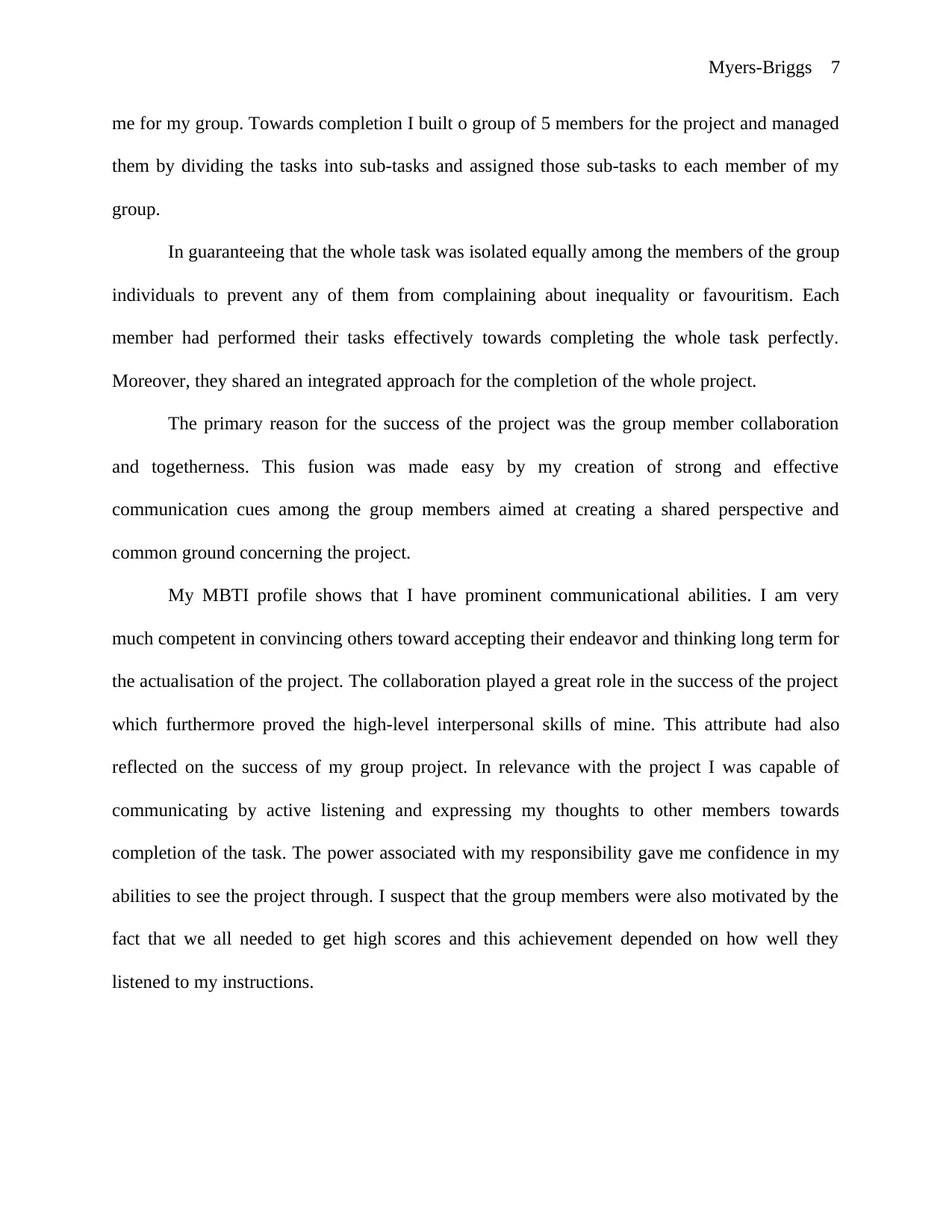
Myers-Briggs 7
me for my group. Towards completion I built o group of 5 members for the project and managed
them by dividing the tasks into sub-tasks and assigned those sub-tasks to each member of my
group.
In guaranteeing that the whole task was isolated equally among the members of the group
individuals to prevent any of them from complaining about inequality or favouritism. Each
member had performed their tasks effectively towards completing the whole task perfectly.
Moreover, they shared an integrated approach for the completion of the whole project.
The primary reason for the success of the project was the group member collaboration
and togetherness. This fusion was made easy by my creation of strong and effective
communication cues among the group members aimed at creating a shared perspective and
common ground concerning the project.
My MBTI profile shows that I have prominent communicational abilities. I am very
much competent in convincing others toward accepting their endeavor and thinking long term for
the actualisation of the project. The collaboration played a great role in the success of the project
which furthermore proved the high-level interpersonal skills of mine. This attribute had also
reflected on the success of my group project. In relevance with the project I was capable of
communicating by active listening and expressing my thoughts to other members towards
completion of the task. The power associated with my responsibility gave me confidence in my
abilities to see the project through. I suspect that the group members were also motivated by the
fact that we all needed to get high scores and this achievement depended on how well they
listened to my instructions.
me for my group. Towards completion I built o group of 5 members for the project and managed
them by dividing the tasks into sub-tasks and assigned those sub-tasks to each member of my
group.
In guaranteeing that the whole task was isolated equally among the members of the group
individuals to prevent any of them from complaining about inequality or favouritism. Each
member had performed their tasks effectively towards completing the whole task perfectly.
Moreover, they shared an integrated approach for the completion of the whole project.
The primary reason for the success of the project was the group member collaboration
and togetherness. This fusion was made easy by my creation of strong and effective
communication cues among the group members aimed at creating a shared perspective and
common ground concerning the project.
My MBTI profile shows that I have prominent communicational abilities. I am very
much competent in convincing others toward accepting their endeavor and thinking long term for
the actualisation of the project. The collaboration played a great role in the success of the project
which furthermore proved the high-level interpersonal skills of mine. This attribute had also
reflected on the success of my group project. In relevance with the project I was capable of
communicating by active listening and expressing my thoughts to other members towards
completion of the task. The power associated with my responsibility gave me confidence in my
abilities to see the project through. I suspect that the group members were also motivated by the
fact that we all needed to get high scores and this achievement depended on how well they
listened to my instructions.
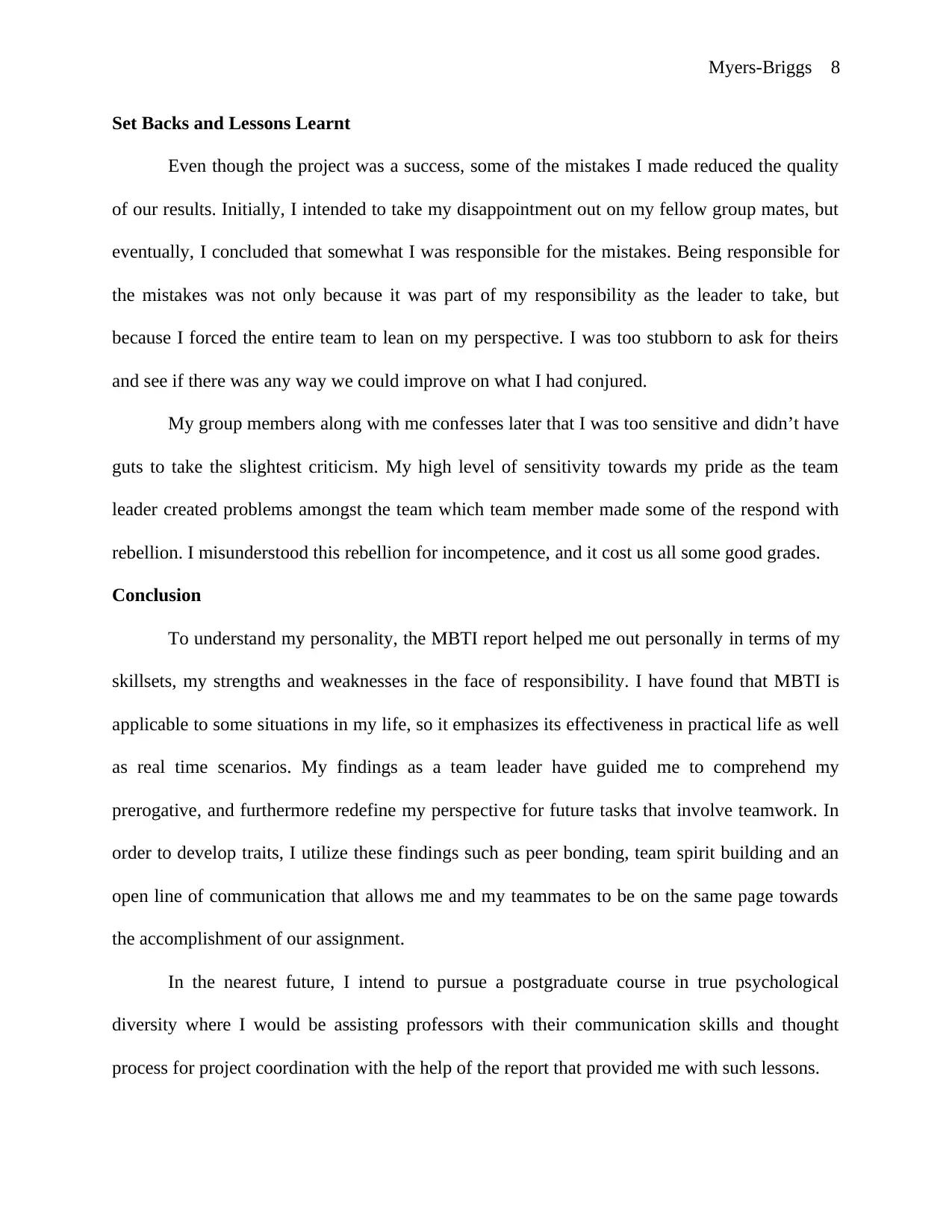
Myers-Briggs 8
Set Backs and Lessons Learnt
Even though the project was a success, some of the mistakes I made reduced the quality
of our results. Initially, I intended to take my disappointment out on my fellow group mates, but
eventually, I concluded that somewhat I was responsible for the mistakes. Being responsible for
the mistakes was not only because it was part of my responsibility as the leader to take, but
because I forced the entire team to lean on my perspective. I was too stubborn to ask for theirs
and see if there was any way we could improve on what I had conjured.
My group members along with me confesses later that I was too sensitive and didn’t have
guts to take the slightest criticism. My high level of sensitivity towards my pride as the team
leader created problems amongst the team which team member made some of the respond with
rebellion. I misunderstood this rebellion for incompetence, and it cost us all some good grades.
Conclusion
To understand my personality, the MBTI report helped me out personally in terms of my
skillsets, my strengths and weaknesses in the face of responsibility. I have found that MBTI is
applicable to some situations in my life, so it emphasizes its effectiveness in practical life as well
as real time scenarios. My findings as a team leader have guided me to comprehend my
prerogative, and furthermore redefine my perspective for future tasks that involve teamwork. In
order to develop traits, I utilize these findings such as peer bonding, team spirit building and an
open line of communication that allows me and my teammates to be on the same page towards
the accomplishment of our assignment.
In the nearest future, I intend to pursue a postgraduate course in true psychological
diversity where I would be assisting professors with their communication skills and thought
process for project coordination with the help of the report that provided me with such lessons.
Set Backs and Lessons Learnt
Even though the project was a success, some of the mistakes I made reduced the quality
of our results. Initially, I intended to take my disappointment out on my fellow group mates, but
eventually, I concluded that somewhat I was responsible for the mistakes. Being responsible for
the mistakes was not only because it was part of my responsibility as the leader to take, but
because I forced the entire team to lean on my perspective. I was too stubborn to ask for theirs
and see if there was any way we could improve on what I had conjured.
My group members along with me confesses later that I was too sensitive and didn’t have
guts to take the slightest criticism. My high level of sensitivity towards my pride as the team
leader created problems amongst the team which team member made some of the respond with
rebellion. I misunderstood this rebellion for incompetence, and it cost us all some good grades.
Conclusion
To understand my personality, the MBTI report helped me out personally in terms of my
skillsets, my strengths and weaknesses in the face of responsibility. I have found that MBTI is
applicable to some situations in my life, so it emphasizes its effectiveness in practical life as well
as real time scenarios. My findings as a team leader have guided me to comprehend my
prerogative, and furthermore redefine my perspective for future tasks that involve teamwork. In
order to develop traits, I utilize these findings such as peer bonding, team spirit building and an
open line of communication that allows me and my teammates to be on the same page towards
the accomplishment of our assignment.
In the nearest future, I intend to pursue a postgraduate course in true psychological
diversity where I would be assisting professors with their communication skills and thought
process for project coordination with the help of the report that provided me with such lessons.
⊘ This is a preview!⊘
Do you want full access?
Subscribe today to unlock all pages.

Trusted by 1+ million students worldwide
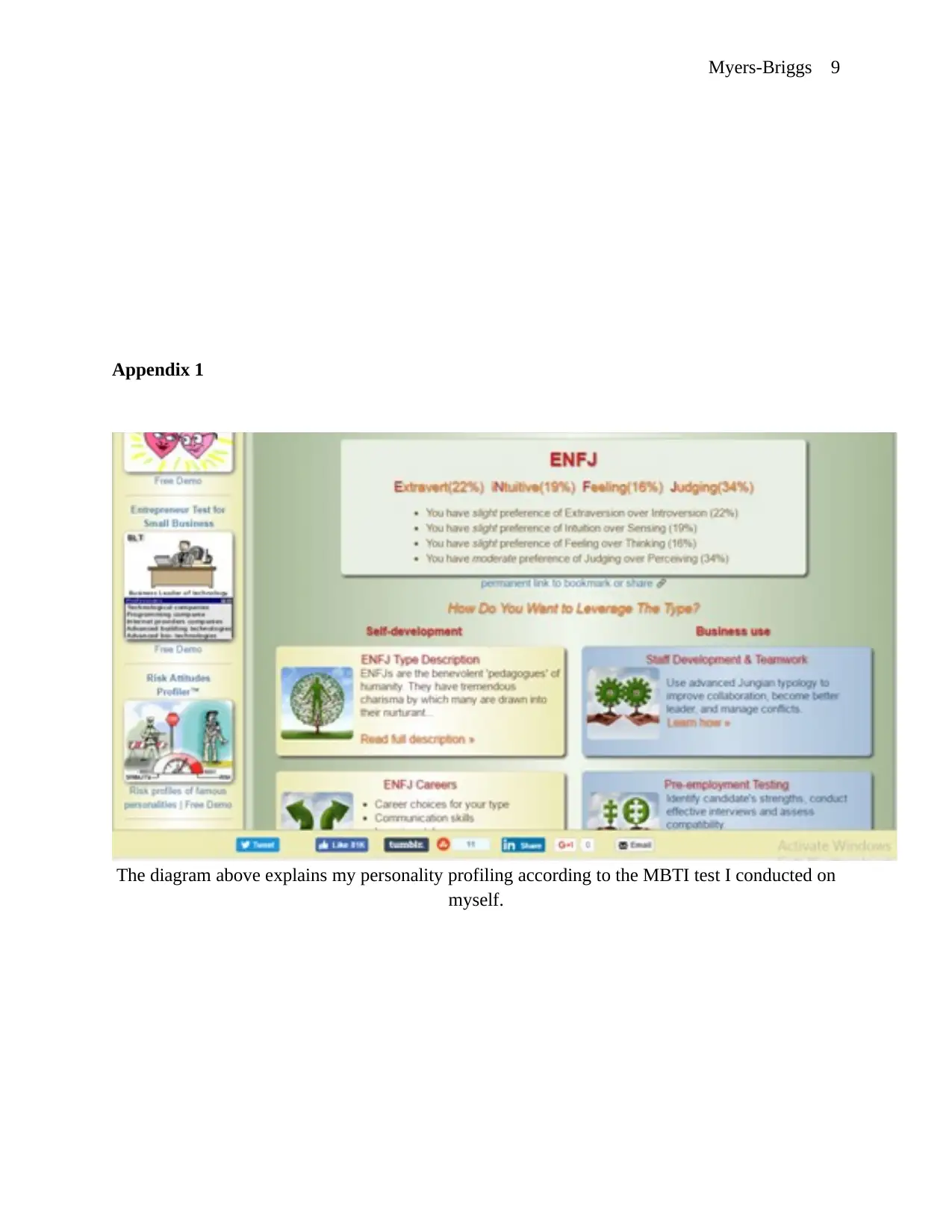
Myers-Briggs 9
Appendix 1
The diagram above explains my personality profiling according to the MBTI test I conducted on
myself.
Appendix 1
The diagram above explains my personality profiling according to the MBTI test I conducted on
myself.
Paraphrase This Document
Need a fresh take? Get an instant paraphrase of this document with our AI Paraphraser
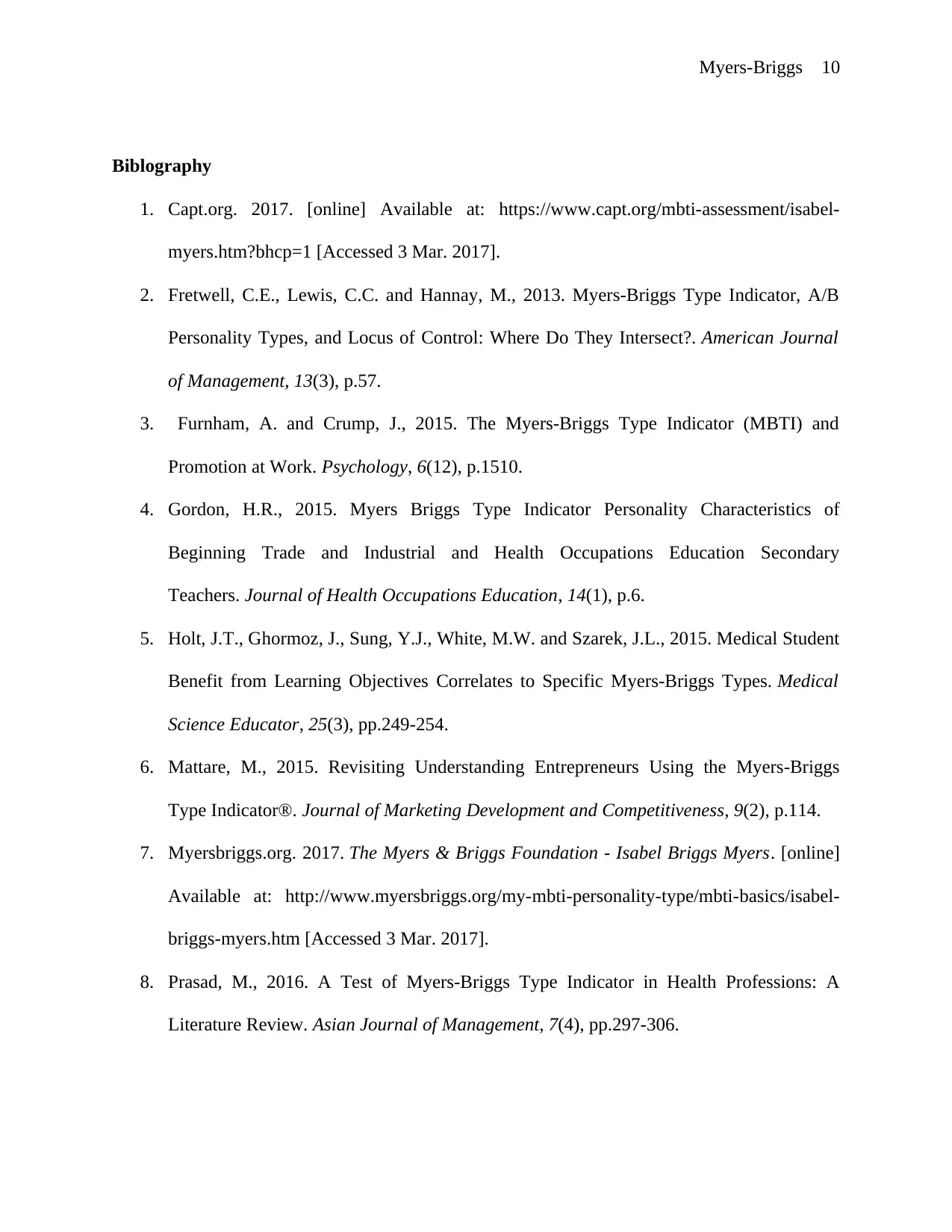
Myers-Briggs 10
Biblography
1. Capt.org. 2017. [online] Available at: https://www.capt.org/mbti-assessment/isabel-
myers.htm?bhcp=1 [Accessed 3 Mar. 2017].
2. Fretwell, C.E., Lewis, C.C. and Hannay, M., 2013. Myers-Briggs Type Indicator, A/B
Personality Types, and Locus of Control: Where Do They Intersect?. American Journal
of Management, 13(3), p.57.
3. Furnham, A. and Crump, J., 2015. The Myers-Briggs Type Indicator (MBTI) and
Promotion at Work. Psychology, 6(12), p.1510.
4. Gordon, H.R., 2015. Myers Briggs Type Indicator Personality Characteristics of
Beginning Trade and Industrial and Health Occupations Education Secondary
Teachers. Journal of Health Occupations Education, 14(1), p.6.
5. Holt, J.T., Ghormoz, J., Sung, Y.J., White, M.W. and Szarek, J.L., 2015. Medical Student
Benefit from Learning Objectives Correlates to Specific Myers-Briggs Types. Medical
Science Educator, 25(3), pp.249-254.
6. Mattare, M., 2015. Revisiting Understanding Entrepreneurs Using the Myers-Briggs
Type Indicator®. Journal of Marketing Development and Competitiveness, 9(2), p.114.
7. Myersbriggs.org. 2017. The Myers & Briggs Foundation - Isabel Briggs Myers. [online]
Available at: http://www.myersbriggs.org/my-mbti-personality-type/mbti-basics/isabel-
briggs-myers.htm [Accessed 3 Mar. 2017].
8. Prasad, M., 2016. A Test of Myers-Briggs Type Indicator in Health Professions: A
Literature Review. Asian Journal of Management, 7(4), pp.297-306.
Biblography
1. Capt.org. 2017. [online] Available at: https://www.capt.org/mbti-assessment/isabel-
myers.htm?bhcp=1 [Accessed 3 Mar. 2017].
2. Fretwell, C.E., Lewis, C.C. and Hannay, M., 2013. Myers-Briggs Type Indicator, A/B
Personality Types, and Locus of Control: Where Do They Intersect?. American Journal
of Management, 13(3), p.57.
3. Furnham, A. and Crump, J., 2015. The Myers-Briggs Type Indicator (MBTI) and
Promotion at Work. Psychology, 6(12), p.1510.
4. Gordon, H.R., 2015. Myers Briggs Type Indicator Personality Characteristics of
Beginning Trade and Industrial and Health Occupations Education Secondary
Teachers. Journal of Health Occupations Education, 14(1), p.6.
5. Holt, J.T., Ghormoz, J., Sung, Y.J., White, M.W. and Szarek, J.L., 2015. Medical Student
Benefit from Learning Objectives Correlates to Specific Myers-Briggs Types. Medical
Science Educator, 25(3), pp.249-254.
6. Mattare, M., 2015. Revisiting Understanding Entrepreneurs Using the Myers-Briggs
Type Indicator®. Journal of Marketing Development and Competitiveness, 9(2), p.114.
7. Myersbriggs.org. 2017. The Myers & Briggs Foundation - Isabel Briggs Myers. [online]
Available at: http://www.myersbriggs.org/my-mbti-personality-type/mbti-basics/isabel-
briggs-myers.htm [Accessed 3 Mar. 2017].
8. Prasad, M., 2016. A Test of Myers-Briggs Type Indicator in Health Professions: A
Literature Review. Asian Journal of Management, 7(4), pp.297-306.
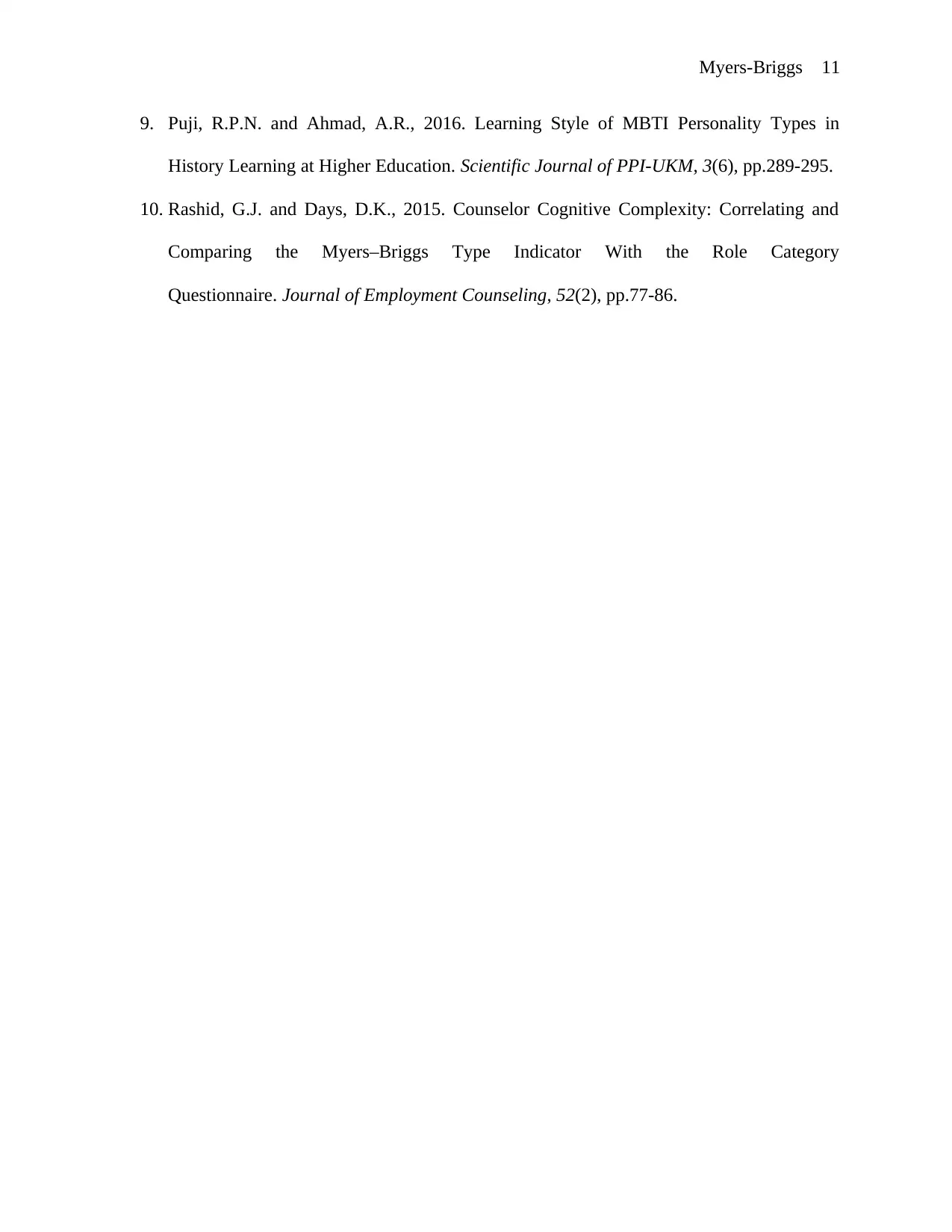
Myers-Briggs 11
9. Puji, R.P.N. and Ahmad, A.R., 2016. Learning Style of MBTI Personality Types in
History Learning at Higher Education. Scientific Journal of PPI-UKM, 3(6), pp.289-295.
10. Rashid, G.J. and Days, D.K., 2015. Counselor Cognitive Complexity: Correlating and
Comparing the Myers–Briggs Type Indicator With the Role Category
Questionnaire. Journal of Employment Counseling, 52(2), pp.77-86.
9. Puji, R.P.N. and Ahmad, A.R., 2016. Learning Style of MBTI Personality Types in
History Learning at Higher Education. Scientific Journal of PPI-UKM, 3(6), pp.289-295.
10. Rashid, G.J. and Days, D.K., 2015. Counselor Cognitive Complexity: Correlating and
Comparing the Myers–Briggs Type Indicator With the Role Category
Questionnaire. Journal of Employment Counseling, 52(2), pp.77-86.
⊘ This is a preview!⊘
Do you want full access?
Subscribe today to unlock all pages.

Trusted by 1+ million students worldwide
1 out of 12
Related Documents
Your All-in-One AI-Powered Toolkit for Academic Success.
+13062052269
info@desklib.com
Available 24*7 on WhatsApp / Email
![[object Object]](/_next/static/media/star-bottom.7253800d.svg)
Unlock your academic potential
Copyright © 2020–2025 A2Z Services. All Rights Reserved. Developed and managed by ZUCOL.





